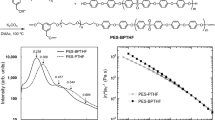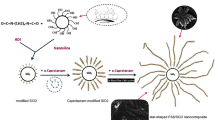Abstract
With the development of nanotechnology, the production and use of the nanocomposites has been increased. Polymer nanocomposites are among the most widely used nanocomposites. In this study, block copolymer and block copolymer-based polymer nanocomposites were synthesized and evaluated. For this purpose; firstly, poly(β-butyrolactone)-b-poly(methyl methacrylate) [P(BL-b-MMA)] block copolymers were prepared simultaneously in one-pot by recycling additive/fragmentation chain transfer (RAFT) and ring-opening (ROP) polymerizations using a novel bifunctional RAFT-ROP agent which synthesized by chemical reaction with 3-bromo-1-propanol and potassium ethyl xanthate. Secondly, for the preparation of polymer nanocomposite, SiO2 nanoparticles were added to the prepared block copolymer with a rate of 3 wt% both during the polymerization stage and after the polymerization stage. The synthesized RAFT-ROP agent, block copolymer, and polymer nanocomposites were characterized using spectroscopic methods. The effect of copolymerization reaction conditions on molecular weight and molecular weight distribution (dispersity) was investigated. In one-pot copolymerization processes, relatively high weight copolymers were obtained by changing the copolymerization conditions due to the active centers in the copolymerization environment. The thermal characterization showed that the glass transition temperature of the block copolymer decreases with the addition of SiO2 during the polymerization stage and increases with the addition of SiO2 after the polymerization stage. SEM surface morphologies showed that block copolymer and polymer nanocomposites morphology is different from each other. The difference can be explained by the good dispersion of the block copolymer and SiO2 nanoparticles within each other.















Similar content being viewed by others
References
Hernández-Téllez CN, Luque-Alcaraz AG, Plascencia-Jatomea M, Higuera-Valenzuela HJ, Burgos-Hernández M, García-Flores N, Álvarez-Ramos ME, Iriqui-Razcon JL, Esquivel Gonzalez R, Hernández-Abril PA (2021) Synthesis and characterization of a Fe3O4@PNIPAM-Chitosan nanocomposite and its potential application in vincristine delivery. Polymers 13:1704. https://doi.org/10.3390/polym13111704
Can A, Sivrikaya H, Hazer B (2018) Fungal inhibition and chemical characterization of wood treated with novel polystyrene-soybean oil copolymer containing silver nanoparticles. Int Biodeterior Biodegrad 133:210–215. https://doi.org/10.1016/j.ibiod.2018.06.022
Ledesma-González T, Pérez-Camacho O, Trevino ME, Lubián RT, Saldívar-Guerra E (2021) Toward functionalized polyolefins from the hydrogenation of isoprene−glycidyl methacrylate copolymers prepared by reversible deactivation radical polymerization in heterogeneous media. Ind Eng Chem Res 60:10826–10833. https://doi.org/10.1021/acs.iecr.1c00620
Hajiali F, Tajbakhsh S, Maric M (2021) Epoxidized block and statistical copolymers reinforced by organophosphorus−titanium−silicon hybrid nanoparticles: morphology and thermal and mechanical properties. ACS Omega 6:11679–11692. https://doi.org/10.1021/acsomega.1c00993
Zheng J, Zhu R, He Z, Cheng G, Wang H, Yao K (2010) Synthesis and characterization of PMMA/SiO2 nanocomposites by in situ suspension polymerization. J Appl Polym Sci 15:1975–1981. https://doi.org/10.1002/app.31258
Cao J, Tan Y, Dai X, Chen Y, Zhang L, Tan J (2021) In situ cross-linking in RAFT-mediated emulsion polymerization: Reshaping the preparation of cross-linked block copolymer nano-objects by polymerization-induced self-assembly. Polymer 230:124095. https://doi.org/10.1016/j.polymer.2021.124095
Radwan EK, El-Naggar ME, Abdel-Karim A, Wassel AR (2021) Multifunctional 3D cationic starch/nanofibrillated cellulose/silver nanoparticles nanocomposite cryogel: synthesis, adsorption, and antibacterial characteristics. Inter J Bio Macromol 189:420–431. https://doi.org/10.1016/j.ijbiomac.2021.08.108
Rudresh M, Maruthi BH, Channakeshavalu K, Nagaswarupa HP (2019) Mechanical and thermal behavior of epoxy based halloysite nano clay/ PMMA hybrid nanocomposites. SN Appl Sci 1:687. https://doi.org/10.1007/s42452-019-0749-0
Chaparro TC, Silva RD, D’Agosto F, Lansalot M, Dalmas F, Chazeau L, Santos AM, Bourgeat-Lami E (2021) Polymer/laponite nanocomposite films produced from surfactant-free latexes using cationic macromolecular reversible addition-fragmentation chain transfer copolymers. Macromolecules 16:7480–7491. https://doi.org/10.1021/acs.macromol.1c01195
Ding Y, Li J, Liu Y, Jia Q, Chen Y (2021) Synthesis of well-defined ABC2, AB2C3, (ABC2)4, and (ABC2)6 miktoarm star-branched polymers by combining organocatalyzed group transfer polymerization and ring-opening polymerization using multialdehydes as chain linkers. Polymer 231:124130. https://doi.org/10.1016/j.polymer.2021.124130
Huo H, Li Z, Tan T, Chen L, Ungar G, Hoogenboom R, Zhang Q, Liu F (2021) Asymmetric incorporation of silver nanoparticles in polymeric assemblies by coassembly of tadpole-like nanoparticles and amphiphilic block copolymer. Macromol Rapid Commun 42:2100354. https://doi.org/10.1002/marc.202100354
Ebrahimi H, Sharif F, SA A. R, (2021) Synthesis and characterization of poly(L-lactide)-block-poly (ε-caprolactone)-grafted titanium dioxide nanoparticles via ring-opening in situ grafting polymerization. Polym Compos 42:3722–3731. https://doi.org/10.1002/pc.26087
Yang L, Zhang YY, Yang GW, Xie R, Wu GP (2021) Controlled Ring-opening polymerization of β-butyrolactone via bifunctional organoboron catalysts. Macromolecules 54:5509–5517. https://doi.org/10.1021/acs.macromol.1c00250
Grobelny Z, Golba S, Jurek-Suliga J (2019) Ring-opening polymerization of β-butyrolactone in the presence of alkali metal salts: investigation of initiation course and determination of polymers structure by MALDI-TOF mass spectrometry. Polym Bull 76:4951–4966. https://doi.org/10.1007/s00289-018-2640-3
Adamus G, Dominski A, Kowalczuk M, Kurcok P, Radecka I (2021) From anionic ring-opening polymerization of β-butyrolactone to biodegradable poly(hydroxyalkanoate)s: our contributions in this field. Polymers 13:4365. https://doi.org/10.3390/polym13244365
Hazer B, Eren M, Senemoğlu Y, Modjinou T, Renard E, Langlois V (2020) Novel poly(3-hydroxy butyrate) macro RAFT agent. Synthesis and characterization of thermoresponsive block copolymers. J Polym Res 27:147. https://doi.org/10.1007/s10965-020-02133-1
Wang Z, Pan X, Fu L, Lathwal S, Olszewsk M, Yan J, Enciso AE, Wang Z, Xia H, Matyjaszewski K (2018) Ultrasonication-induced aqueous atom transfer radical polymerization. ACS Macro Lett 7:275–280. https://doi.org/10.1021/acsmacrolett.8b00027
Wang JS, Matyjaszewski K (1995) Controlled/"living" radical polymerization. Halogen atom transfer radical polymerization promoted by a Cu(I)/Cu(II) redox process. Macromolecules 28:7901–7910. https://doi.org/10.1021/ma00127a042
Corrigan N, Jung K, Moad G, Hawker CJ, Matyjaszewski K, Boyer C (2020) Reversible-deactivation radical polymerization (controlled/living radical polymerization): from discovery to materials design and applications. Prog Polym Sci 111:101311. https://doi.org/10.1016/j.progpolymsci.2020.101311
Chong YK, Krstina J, Le TPT, Moad G, Postma A, Rizzardo E, Thang SH (2003) Thiocarbonylthio compounds [S=C(Ph)S-R] in free radical polymerization with reversible addition-fragmentation chain transfer (RAFT polymerization). Role of the free-radical leaving group (R). Macromolecules 36:2256–2272. https://doi.org/10.1021/ma020882h
Göktaş M (2020) Synthesis and characterization of temperature-responsive block copolymers using macromonomeric initiator. Chem Papers 74:2297–2307. https://doi.org/10.1007/s11696-020-01074-9
Göktaş M, Olgun B (2019) One-step synthesis and characterization of poly(ε-caprolactone)-b-poly(N-isopropylacrylamide) thermo-responsive block copolymers via RAFT and ROP techniques. Polym Sci Ser B 61:421–429. https://doi.org/10.1134/s1560090419040055
Göktaş M (2019) Synthesis and characterization of various block copolymers using PMMA-Br macroinitiator. Chem Papers 73:2329–2339. https://doi.org/10.1007/s11696-019-00785-y
Göktaş M, Öztürk T, Atalar MN, Tekeş AT, Hazer B (2014) One-step synthesis of triblock copolymers via simultaneous reversible-addition fragmentation chain transfer (RAFT) and ring-opening polymerization using a novel difunctional macro-RAFT agent based on polyethylene glycol. J Macromol Sci Part A Pure Appl Chem 51:854–863. https://doi.org/10.1080/10601325.2014.953366
Pal A, Pal S (2017) Synthesis of poly (ethylene glycol)-block-poly (acrylamide)-block-poly (lactide) amphiphilic copolymer through ATRP, ROP and click chemistry: characterization, micellization and pH-triggered sustained release behaviour. Polymer 127:150–158. https://doi.org/10.1016/j.polymer.2017.08.048
Göktaş M (2019) Synthesis and characterization of poly (styrene-b-methyl methacrylate) block copolymers via ATRP and RAFT. J Inst Sci Technol 9:139–149. https://doi.org/10.21597/jist.435934
Göktaş M, Deng G (2018) Synthesis of poly(methyl methacrylate)-b-poly(N-isopropylacrylamide) block copolymer by redox polymerization and atom transfer radical polymerization. Indones J Chem 18:537–543. https://doi.org/10.22146/ijc.28645
Göktaş M (2019) Copolymer synthesis with redox polymerization and free radical polymerization systems. Redox Rozina Khattak IntechOpen. https://doi.org/10.5772/İntechopen.88088
Göktaş M, Aykaç C (2020) Synthesis and characterization of poly(ε-caprolactone)-b-poly(acrylamide) block copolymers. J İnst Sci Technol 10:1154–1162. https://doi.org/10.21597/jist.659032
Göktaş M, Aykaç C, Öztürk T (2022) One-step synthesis and characterization of the block-graft terpolymer via simultaneous atom transfer radical polymerization (ATRP) and ring-opening polymerization (ROP) techniques. J Chem Sci 134:73. https://doi.org/10.1007/s12039-022-02068-8
Öztürk T, Yavuz M, Göktaş M, Hazer B (2016) One-step synthesis of triarm block copolymers by simultaneous atom transfer radical and ring-opening polymerization. Polym Bull 73:1497–1513. https://doi.org/10.1021/ja00125a035
Dubey RS, Rajesh YBRD, More MA (2015) Synthesis and characterization of SiO2 nanoparticles via sol-gel method for industrial applications. Mater Today Proc 2:3575–3579. https://doi.org/10.1016/j.matpr.2015.07.098
Akinay Y, Akkuş IN (2020) Synthesis and characterization of the pearlescent pigments based on mica deposited with SiO2, AlN and TiO2: first report of its dielectric properties. Ceram Int 46:17735–17740. https://doi.org/10.1016/j.ceramint.2020.04.078
Huang X, Yuan Y, Liu S, Wang W, Hong R (2017) One-step sol-gel preparation of hydrophobic antireflective SiO2 coating on poly (methyl methacrylate) substrate. Mater Lett 208:62–64. https://doi.org/10.1016/j.matlet.2017.05.028
Matsuura K, Kuboyama K, Ougizawa T (2021) Effect of tacticity of poly (methyl methacrylate) on interfacial region with silica in polymer nanocomposite. Polym Eng Sci 61:77–84. https://doi.org/10.1002/pen.25556
Tilioua A (2021) Investigation of the thermo-physical properties of poly (methyl methacrylate)-based plexiglass to improve the performance of solar cells. Mat Sci Ener Technol 4:349–356. https://doi.org/10.1016/j.mset.2021.08.011
Zidan TA (2020) Synthesis and characterization of modified properties of poly (methyl methacrylate)/organoclay nanocomposites. Polym Compos 41:564–572. https://doi.org/10.1002/pc.25388
Hirata T, Kashiwagi T, Brown JE (1985) Thermal and oxidative degradation of poly (methyl methacrylate): weight loss. Macromolecules 18:1410–1418. https://doi.org/10.1021/ma00149a010
Acknowledgements
This work was supported by the Van Yüzünci Yıl University Scientific Research Fund (Grand Number: FYL-2020-9254).
Author information
Authors and Affiliations
Corresponding author
Additional information
Publisher's Note
Springer Nature remains neutral with regard to jurisdictional claims in published maps and institutional affiliations.
Rights and permissions
Springer Nature or its licensor holds exclusive rights to this article under a publishing agreement with the author(s) or other rightsholder(s); author self-archiving of the accepted manuscript version of this article is solely governed by the terms of such publishing agreement and applicable law.
About this article
Cite this article
Göktaş, M., Aykaç, C. & Akinay, Y. Synthesis and characterization of block copolymer: thermal and morphological properties of SiO2-filled block copolymer nanocomposites. Polym. Bull. 80, 8565–8584 (2023). https://doi.org/10.1007/s00289-022-04468-9
Received:
Revised:
Accepted:
Published:
Issue Date:
DOI: https://doi.org/10.1007/s00289-022-04468-9




